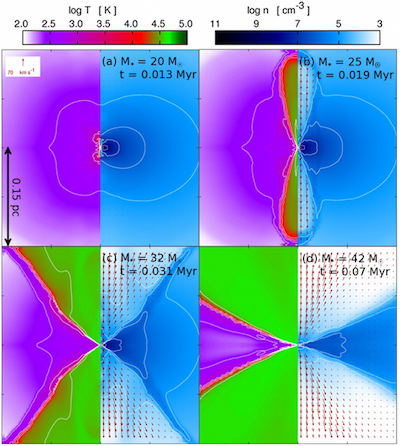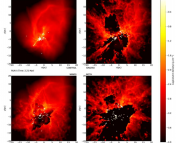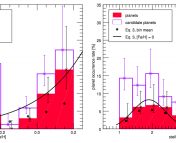Title: On the Effects of Optically Thick Gas (Disks) Around Massive Stars
Authors: Rolf Kuiper & Harold W. Yorke
First Author’s Institution: Jet Propulsion Laboratory, California Institute of Technology, 4800 Oak Grove Drive, Pasadena, CA 91109, USA
Making massive stars can be quite difficult. As a massive star accretes matter during its formation it will contract towards the main sequence very quickly, reaching its main sequence luminosity while it is still accreting material from its natal cloud. For example, a 40 solar mass star has a zero age main sequence luminosity that is ~230,000 times that of the sun. If the star is accreting material isotropically, then the radiation from the star is strong enough to halt accretion! This is because the stellar radiation is exerting an outward force on the infalling material, counteracting the inward gravitational force. If the stellar luminosity is large enough, accretion will be slowed down and even halted by the stellar radiation. This is known as the Eddington limit, and depends on the mass and luminosity of the star, and how efficiently the accreting material absorbs the incident radiation (i.e., the opacity of the accreting material).
Luckily for massive stars, the universe is not spherically symmetric. One way to avoid this “radiation barrier” problem is to have a highly anisotropic radiation field emitted from the star. This occurs with the presence of a dense and optically thick circumstellar accretion disk which feeds matter to the star because the radiation will flow freely out of the optically thin bipolar regions. This anisotropic accretion flow arises naturally from an accretion disk which forms around the accreting star as a result of angular momentum conservation. This is because the dense molecular cloud cores out of which stars form are slowly rotating and as they collapse the core material is circularized far from the star resulting in an accretion disk that funnels material onto the star. This disk will be very dense and optically thick, thus allowing radiation to escape the bipolar regions of the star while disk material accretes onto the star.
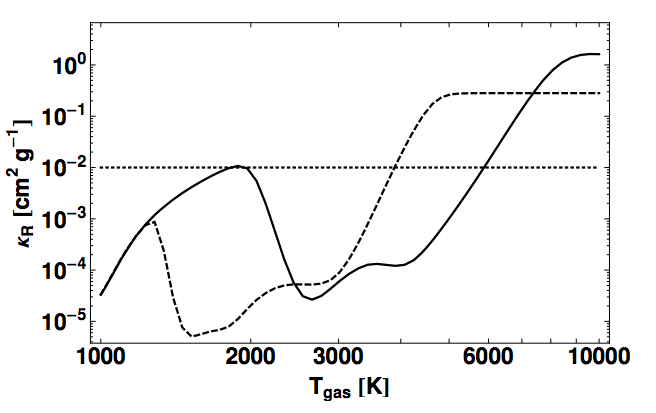
Rosseland mean gas opacities as a function of the gas temperature for two values of the gas density, ρ=10-11 g cm-3 (solid line) and ρ=10-20 g cm-3 (dashed line). The horizontal line indicates the constant gas opacity used in the comparison run.
The effect of accretion onto the star is highly dependent on how well the disk material can absorb the incident radiation. This is because the radiation force is proportional to the opacity of the material. In this article, the authors perform simulations with the magnetohydrodynamics code Pluto of the formation of a massive star and correctly account for the gas and dust opacities of the accretion disk and core material. The opacity of a material depends on its composition, density, and temperature. The figure above shows an example of the Rosseland mean gas opacities (i.e., gas opacity averaged over frequency and weighted by the temperature derivative of the Planck distribution) used in their simulation as a function of temperature for two different densities. They compare their fiducial simulation to a comparison run where they hold the opacity constant at 0.01 cm2 g-1, as indicated by the dotted line.
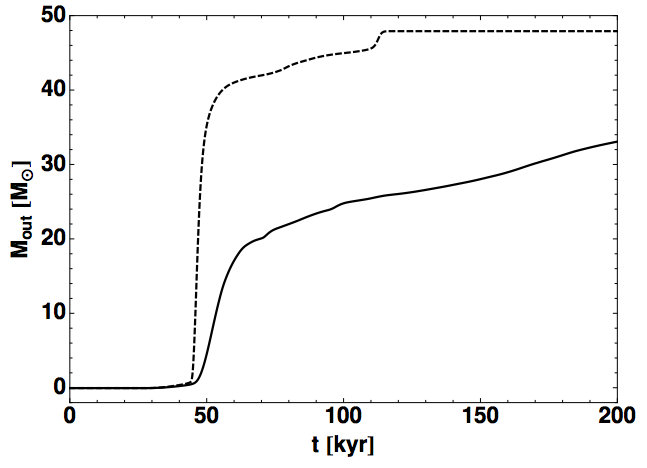
Mass-loss of the pre-stellar molecular cores due to radiative acceleration as a function of time. The solid line denotes the fiducial run which uses the correct gas opacities whereas the dotted line shows the comparison run which uses a constant gas opacity.
The authors start out with a pre-stellar core of mass 100 solar masses, an outer core radius of 0.1 pc, and a temperature of 20 K. The core is initially in solid body rotation. They compare two runs: the fiducial run which includes the correct gas and dust opacities and the comparison run with the same initial conditions but the gas opacity held constant at 0.01 cm2 g-1. The authors find that during the free-fall epoch and early formation of the accretion disk, there is little to no difference in the two runs. However, as the simulation progresses and the central star becomes very bright, the radiative force exerted by the star on its environment becomes strong enough to overcome gravity and lead to significant mass loss from the core, leading to radiation-pressure dominated cavities. As can be seen in the figure above, more mass is lost in the comparison case than in the fiducial case. This is because the opening angle of the radiation-driven outflow for the fiducial case is smaller than the comparison case resulting in different mass-loss rates from the core as can be seen in the density distribution figure below.

Mass of the central star (upper panel) and accretion rate onto the star (lower panel) as a function of time. The solid lines represent the fiducial case and the dashed lines denote the comparison run.
The accretion histories and disk lifetimes for both cases are also quite different. The accretion rates look nearly identical for the first ~50 kyr. After this time, the accretion rate for the comparison case drops much more rapidly than for the fiducial case and even stops at ~65 kyr due to the radiative forces exerted by the star, as shown in the figure on the right. After the initial shutoff in the accretion rate for the comparison case, mass builds up in the disk and leads to an epoch of low accretion up to ~90 kyr until the disk is dispersed by the stellar radiation. This is because the density in the disk drops since much more gas has been ejected from the core in the comparison case, causing the radiative force to dominate over gravity much earlier than for the fiducial case. The authors find that in the fiducial case, the disk survives for much longer with a sustained accretion rate that slowly declines with time, leading to a more massive star at the end of their simulations.

